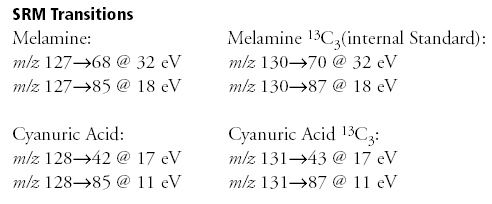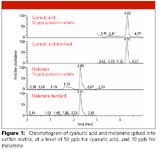Analysis of Melamine and Cyanuric Acid in Food Matrices by LC–MS-MS
The Application Notebook
In March 2007, several North American manufacturers of pet food voluntarily issued nationwide recall notices for some of their products that were reportedly associated with renal failure in pets. The raw material wheat gluten, used to manufacture the pet food, was imported from China and was identified as the source of contamination.
In March 2007, several North American manufacturers of pet food voluntarily issued nationwide recall notices for some of their products that were reportedly associated with renal failure in pets. The raw material wheat gluten, used to manufacture the pet food, was imported from China and was identified as the source of contamination.
Although initial reports suggested that contamination was confined to pet food, further investigations revealed that melamine-tainted fodder may have been used to feed animals intended for human consumption (1,2). In particular, it was discovered that melamine-contaminated ingredients had been used to prepare feed for chickens, swine, and catfish (1,2). Consequently, the U.S. Food and Drug Administration (FDA) (1) and the U.S. Department of Agriculture (USDA) (2) have developed methods for the analysis of melamine residues in animal tissue. This note describes a method for the detection and analysis of melamine and cyanuric acid in food matrices by LC–MS-MS using the Thermo Scientific TSQ Quantum Ultra™ mass spectrometry system.
Experimental Conditions
Sample Preparation
Solid samples were homogenized using an Ultra-Turrax® (IKA® -Werke GmbH & Co. KG, Staufen, Germany) homogenizer. After extraction into aqueous 1:1 Water:MeOH, and addition of the internal standards, the samples were prepared by offline ion exchange chromatography using SPE cartridges.
Liquid Chromatography
Aliquots (10-25 μL) of the above extract were chromatographed on a BioBasic™ AX (Thermo Fisher Scientific, Bellefonte, Pennsylvania) analytical column (2.1 × 150 mm, 5 μm), which was kept at 30°C in an oven.
MS Conditions
MS: TSQ Quantum Ultra
Source: Heated Electrospray (H-ESI)
Ionization: Positive ESI

Results
Calibration curves ranged from 1–1000 ppb for melamine and cyanuric acid, respectively. Melamine and cyanuric acid were spiked into a matrix of catfish and processed as described above. A chromatogram of this sample, spiked at 10 ppb for melamine and 50 ppb for cyanuric acid, is shown in Figure 1. Very low noise is observed, emphasizing the effectiveness of the cleanup procedure for a complicated matrix.

Figure 1
Conclusion
A simple, sensitive, and specific method for the detection and quantitation of melamine and cyanuric acid in food matrices has been demonstrated. The method is robust and allows for the analysis of a large number of samples, without degradation in column performance.
References
(1) Weise, E. and Schmit, J. Melamine in pet food may not be accidental. USA Today. Available at www.usatoday.com/money/industries/2007-04-24-fda-pet-food-probe_N.htm.
(2) Fish on U.S. fish farms fed melamine-contaminated feed; FDA discovers contaminated food products from China mislabeled. American Veterinary Medical Association. Available at www.avma.org/press/releases/070508_petfoodrecall.asp. Accessed 10 December 2007.

Thermo Fisher Scientific Inc.
355 River Oaks Parkway, San Jose, CA 95134-1991
tel. +1 800-532-4752; fax +1 561-688-8731

Analytical Challenges in Measuring Migration from Food Contact Materials
November 2nd 2015Food contact materials contain low molecular weight additives and processing aids which can migrate into foods leading to trace levels of contamination. Food safety is ensured through regulations, comprising compositional controls and migration limits, which present a significant analytical challenge to the food industry to ensure compliance and demonstrate due diligence. Of the various analytical approaches, LC-MS/MS has proved to be an essential tool in monitoring migration of target compounds into foods, and more sophisticated approaches such as LC-high resolution MS (Orbitrap) are being increasingly used for untargeted analysis to monitor non-intentionally added substances. This podcast will provide an overview to this area, illustrated with various applications showing current approaches being employed.

.png&w=3840&q=75)

.png&w=3840&q=75)



.png&w=3840&q=75)



.png&w=3840&q=75)















